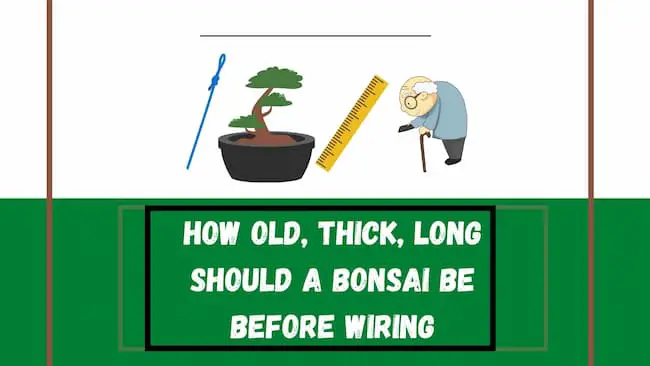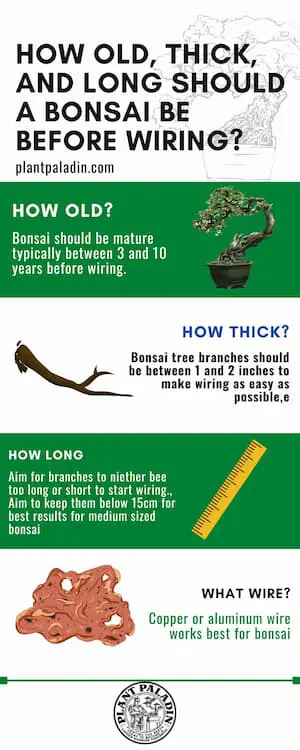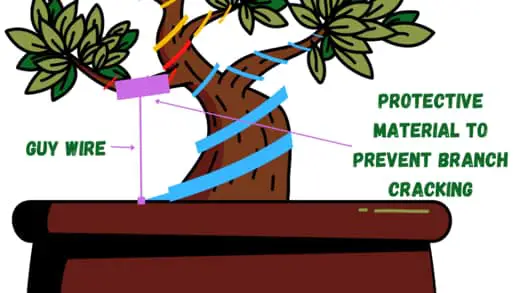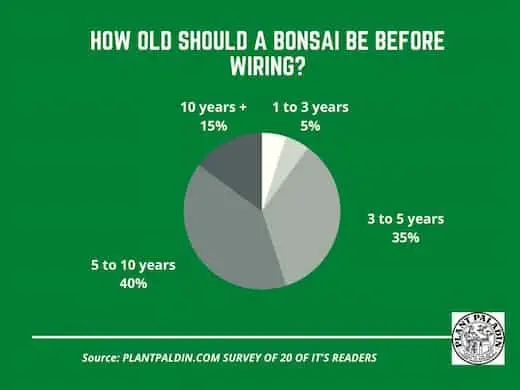This website is supported by its readers. If you click one of my links I may earn a commission. I am also a participant in the Amazon affiliates program and I will also earn a commission from qualified purchases.

Have you ever marveled at the intricate and elegant shapes of bonsai trees? Wondered how they are crafted with precision and artistry? The ancient art of bonsai involves cultivating small trees in pots or containers, using techniques such as wiring to shape and train the branches and trunk into the desired form.
But when is the ideal time to wire a bonsai tree, and what factors should be considered?
Depending on the species, bonsai trees should be 3 to 10 years old, and the trunk should be 1 to 2 inches thick before wiring. Also, it is better to wire branches before they get too long, as it can be challenging to shape them once they have grown too long.
This article will delve into the nuances of bonsai wiring and guide how to wire your bonsai tree at the optimal age, thickness, and length.
Just a quick heads up, over the past three years of running Plantpaladin, hundreds of people have asked for product recommendations. As such, You can find my favorite indoor bonsai tree here (link takes you to Bonsaiboy), my favorite outdoor bonsai tree (link takes you to Bonsaiboy), or have a look at all the products I recommend here.

How Old Should a Bonsai Be Before Wiring?
One crucial factor to consider when determining the appropriate age for wiring a bonsai tree is the species of the tree.
Different species have different growth patterns and characteristics; some are better suited for wiring at certain ages than others.
Generally, it is best to wait until a bonsai tree has reached a certain level of maturity before wiring, as younger trees may need more developed branches to make wiring worthwhile. Bonsai trees’ maturity is typically reached between 3 and 10 years, depending on the species.
Below is a table showing the age ranges when it is generally appropriate to wire different species of bonsai trees:
Species | Age range for wiring |
Pine | 3-5 years |
Maple | 3-5 years |
Oak | 5-7 years |
Elm | 5-7 years |
Ginkgo | 5-7 years |
Larch | 5-7 years |
Spruce | 5-7 years |
Cedar | 7-10 years |
Cypress | 7-10 years |
Sequoia | 7-10 years |
Fir | 7-10 years |
Beech | 10+ years |
Birch | 10+ years |
Horse chestnut | 10+ years |
Zelkova | 10+ years |
It is important to note that these age ranges are only general guidelines and may vary depending on the bonsai tree’s specific conditions and growth rate.
In some cases, it may be appropriate to wire a bonsai tree at an earlier or later age than the ranges listed above.
How Thick Should a Bonsai Be Before Wiring?
Keeping a bonsai tree branch between one to two inches will work best to wire most medium-sized bonsai trees. Branches any thicker than this will be tougher to train and shape.
The thickness of a bonsai tree’s branches is another critical factor to consider when determining the appropriate time for wiring.
Thicker branches are generally more resistant to damage from wiring and are more likely to hold their shape after being wired.
On the other hand, thin branches are more delicate and may break or deform easily if wired improperly.
Below is a table showing the appropriate thickness ranges for different wiring parts of a bonsai tree:
Part of tree | Thickness range for wiring |
Trunk | 1-2 inches |
Primary branches | 1/2-1 inch |
Secondary branches | 1/4-1/2 inch |
Tertiary branches | 1/8-1/4 inch |
As with the age of a bonsai tree, these thickness ranges are only general guidelines and may vary depending on the specific species and characteristics of the tree.
In some cases, it may be appropriate to wire thicker or thinner branches than the ranges listed above.

When selecting wire for your bonsai tree, ensure the wire is 1/3rd the size of your bonsai tree branch
How Long Should a Bonsai Branch Be Before Wiring?
The length of a bonsai branch is another essential aspect to consider when determining the appropriate time for wiring.
For most medium-sized bonsai trees keeping the branches no longer than 15cm is the perfect length for wiring. Branches any longer than this tend to become unwieldy.

Generally, it is best to wire longer branches before they get too long, as it can be more challenging to shape and train them once they have grown too long.
On the other hand, it is usually best to wait until a branch has grown to a sufficient length before wiring, as shorter branches may not have enough mass to hold their shape after being wired.
Generally, it is usually best to wait until a bonsai branch has grown to at least half its desired length before wiring it.
This will allow the branch to develop sufficient mass and strength to hold its shape after being wired while providing enough room for further shaping and training.
On top of this, you may need to grow a sacrifice bonsai branch in your tree’s first few years before it reaches maturity.
This will help your tree thicken its trunk, which is vital for creating an aesthetically pleasing bonsai tree.
To summarize:
- The age, thickness, and length of a bonsai plant before wiring largely depend on the particular species.
- The bonsai tree needs to reach a certain level of maturity before wiring.
- Wiring a bonsai tree can be challenging to shape once the branches have grown too long.
- Short branches might need more mass to hold the desired shape after you wire them.
- Avoid wiring too tightly, as this will hinder the growth and potentially harm the tree.
What Species of Bonsai Are Best For Wiring?
Not all species of bonsai trees are equally suitable for wiring.
Some species are more flexible and easier to shape through wiring, while others are more rigid and resistant to shaping.
Below is a list of some of the most common bonsai species and their suitability for wiring:
- Pines and Junipers: These species are prevalent for bonsai cultivation and are generally quite suitable for wiring. They have flexible branches that are relatively easy to shape through wiring.
- Maples: Maples are another popular bonsai species and are generally well-suited for wiring. They have relatively flexible branches that can be easily shaped, although their delicate foliage can be damaged by heavy wiring.
- Oaks and Elms: These species have more rigid branches that are more difficult to shape through wiring. They may require more time and effort to shape and train and may be more prone to damage from the wiring.
- Ficus and Jade: These species have very flexible branches that are easy to shape through wiring. However, they can be prone to rot and decay if wired improperly, and you must ensure that they are not over-watered or kept in humid conditions.
Where Should You Wire a Bonsai?
When wiring a bonsai tree, it is crucial to carefully consider where to apply the wire to achieve the desired shape and form.
A common approach is to wire the branches near the tree’s base, allowing for greater control and manipulation of the tree’s overall structure.

This will also create an anchor making it much easier to wire the branches of your tree.
However, it is essential to exercise caution and avoid wiring the branches too tightly, as this can cause harm to the tree and potentially hinder its growth.
One of the critical considerations when wiring a bonsai is to avoid applying the wire too tightly, as this can lead to damage or scarring on the branches.
Instead, the wire should be applied with a gentle, firm pressure that allows for movement and flexibility while still providing enough support to shape the tree into the desired form.
In addition to avoiding damage to the tree, this approach will allow for more natural and harmonious growth over time.
Another critical factor when wiring a bonsai is the tree’s overall health and vigor.
It is generally best to wire a tree during active growth, as this allows for easier bending and shaping of the branches.
However, it is also essential to be mindful of the tree’s energy levels and not over-stress it by wiring too many branches.
By following these guidelines and using a careful and thoughtful approach, you can successfully wire your bonsai tree and shape it into a beautiful and graceful form.
What wire should you use for your bonsai?
Aluminum and copper wires are the best types to use when wiring your bonsai tree. If you want to avoid metal wire, consider using organic alternatives such as jute rope.
I’ve written a post about how to shape a bonsai tree without wire which you can find here.
How To Wire a Bonsai?
So now we know the general parameters and sizes required for wiring your bonsai. What is the exact step-by-step process when it comes to wiring your bonsai?
Now I’ve written an individual post covering this in a little more detail, but to summarize:
Wiring a bonsai tree is a technique that requires some practice and skill to master. Below is a general guide for how to wire a bonsai tree:
Select a Suitable Wire
Begin by selecting a suitable wire for the tree. Aluminum wire is a common choice for bonsai wiring, as it is strong, flexible, and easily shaped to fit the tree’s form.
Copper wire is also a good choice, although it is more expensive and may be more prone to breaking.

Wrap The Wire Properly
Start by wrapping the wire around the base of the branch you want to shape. Leave about an inch of wire at the end of the branch to allow for adjustment.

Shape The Branches
Slowly and gently shape the branch into the desired form, using the wire to hold it.
Be careful not to apply too much pressure, which can cause the branch to break or deform.

Secure The Wire
Once the branch is in the desired shape, secure it by wrapping it around its base a few times.
Leave enough slack in the wire to allow further growth and movement.


Repeat the process for any additional branches you want to shape.
Make Necessary Adjustments
Check the wire periodically to ensure it is not cutting into the tree or causing any damage. If necessary, adjust the wire to alleviate pressure points or loosen it to allow for further growth.
Is Wiring Bad For Bonsai?
Wiring is a common and generally safe technique for shaping and training bonsai trees. However, it is essential to use caution and care when wiring a bonsai tree to avoid causing damage.
Some potential risks and drawbacks of wiring include
- Damage to the tree: If the wire is applied too tightly or left in place for too long, it can cause damage to the tree’s branches and trunk. This can include deformation, scarring, or even breakage.
- Stress to the tree: Wiring can be stressful for a bonsai tree, especially if done improperly or on an immature tree. It is essential to minimize the stress on the tree by applying the wire gently and carefully and removing it as soon as it is no longer needed.
- Inhibition of growth: If the wire is applied too tightly or left in place for too long, it can inhibit the tree’s growth and development. This can result in a less healthy and less aesthetically pleasing tree.
What Should You Avoid When Wiring Bonsai?
It is essential to avoid the following mistakes:
- Applying the wire too tightly: This can cause damage to the tree and inhibit its growth. Ensure enough slack in the wire to allow for movement and further growth.
- Leaving the wire in place for too long: It is essential to remove the wire as soon as it is no longer needed to avoid causing damage or inhibiting growth.
- Wiring immature trees: It is generally best to wait until a bonsai tree has reached a certain level of maturity. Doing so will allow the tree to develop sufficient strength and mass to hold its shape after being wired.
- Wiring the wrong part of the tree: It’s generally best to wire the branches near the tree’s base, as this will allow for better control and shape of the tree’s overall form.
How Long Does Bonsai Need To Be Wired?
The length of time that you should wire a bonsai tree depends on several factors, including the tree’s species, the tree’s age, and the tree’s desired shape.
Leave the wire in place for as long as necessary to achieve the desired shape. This may be a few weeks for some trees or several months for others.
Once the desired shape has been achieved, you should carefully remove the wire to avoid causing any damage to the tree.
If the tree’s shape changes after wiring, it may be necessary to reapply the wire later to maintain the desired shape.
Related Questions
Can You Wire a Bonsai Tree Any Time of Year?
It is generally best to avoid wiring a bonsai tree during periods of active growth, as this can cause stress to the tree and may hinder its growth. Instead, you should wire a bonsai tree during periods of dormancy when the tree is not actively growing.
This will allow the tree to recover more quickly from the stress of wiring and will minimize the risk of damage.

How Do You Know If You Have Wired a Bonsai Tree Too Tightly?
If a bonsai tree is wired too tightly, it may show signs of stress or damage. These signs can include:
- Deformed or bent branches
- Broken or split branches
- Scarring or marks on the branches or trunk
- Discoloration or yellowing of the leaves.
If you notice any of these signs, it is essential to loosen the wire to relieve the pressure on the tree.
Can You Wire a Bonsai Tree More Than Once?
Yes, it is possible to wire a bonsai tree more than once. It is often necessary to wire a bonsai tree multiple times to achieve and maintain the desired shape.
It is essential to minimize the number of times the tree is wired.
Avoid wiring it too frequently, as this can cause stress and damage to the tree.
How Long Does It Take For a Bonsai Tree To Grow An Inch?
The rate at which a bonsai tree grows can vary significantly depending on several factors, including the tree species, its age, the climate in which it is grown, and the care it receives.
In general, younger bonsai trees tend to grow more quickly than older ones, and some species may grow more quickly than others. As a rough estimate, it is common for a bonsai tree to grow about an inch per year, but this can vary widely.
When Should You Start Shaping Your Bonsai Tree?
The best time to start shaping a bonsai tree depends on its species and age. It is ideal to wait until a tree has reached a certain level of maturity before attempting to shape it, as this will allow for easier bending and shaping of the branches.
Generally, waiting until a tree is at least three years old is recommended before attempting to shape it. However, this can vary depending on the tree species and its overall health and vitality.
How Can You Tell How Old a Bonsai Tree Is?
There are a few ways to determine the age of a bonsai tree. One method is to look for visible signs of age, such as thick, gnarled roots or a thick, well-established trunk. Another method is to consider the size of the tree and compare it to known growth rates for the species.
Ask the person who grew the tree or sold it to you, as they may have records or information about its age.
What Does an Unhealthy Bonsai Look Like?
An unhealthy bonsai tree may exhibit several signs, including yellowing or wilting leaves, sparse or thin foliage, and a lack of new growth. It may also show signs of pests or diseases, such as black or brown spots on the leaves or bark or abnormal growth patterns.
An unhealthy bonsai tree may appear weak or stunted, with a thin or spindly trunk and branches.
How Much is a Mature Bonsai Tree Worth?
The value of a mature bonsai tree can vary significantly depending on several factors, including the tree species, its age, the quality of its care, and its overall appearance.
On average, mature bonsai trees that are well-established and have been carefully cared for can be worth $100 – $1000.
The value of a bonsai tree is often subjective and can depend on the individual buyer’s preferences and interests.
Survey results
I didn’t want to give my opinion but get in touch with a few experts.
I undertook a quick survey to determine how old, thick, and long your bonsai tree needs before wiring.
To summarize:

Final Thoughts
In conclusion, wiring is a valuable technique for shaping and training bonsai trees.
It is essential to approach it carefully.
By considering the tree’s age, thickness, and length. (As well as the appropriate species and location for wiring). You can effectively shape your bonsai tree into the desired form while minimizing the risk of damage and stress.
As with bonsai cultivation, patience and attention to detail are crucial to success. You can create a beautiful and healthy bonsai tree by carefully planning and executing your wiring techniques.
My top picks for the gear you will need!
So like I mentioned earlier, over the past three years of running PlantPaladin, hundreds of people have asked me for my recommendations on the best bonsai gear on the market.
Having spent thousands of dollars on bonsai items these past few years and tested at least 100 bonsai-specific products, I’ve listed my favorite products below – All of which I highly recommend and think you can get great value.
They can purchase directly by clicking the link to take them to Amazon.
Bonsai Tool Set: One of the significant challenges I’ve had is finding a toolset that was not only durable but didn’t break the bank. SOLIGT has recently developed a fantastic bonsai tool set that covers all the tools you need to trim, prune, and repot your trees. – You can grab it here.
Complete Bonsai Set: Many of you will want to grow your bonsai trees entirely from scratch, but finding the varicose seeds, pots, and other items in one place can be challenging. Leaves and Sole then have created a complete bonsai set that I’ve personally used that ticks all the boxes. You can grab it here.
Bonsai wire: The number of times I’ve run out of wire for my bonsai or purchased cheap bonsai wire that doesn’t do the job is embarrassing for me to admit. After a lot of trial and error, I found that using Hotop’s aluminum bonsai wire is one of the best options on the market. This can easily be used for both indoor and outdoor bonsai. You can grab it here.
This post was written by Fehed Nicass, who has been passionate about bonsai for over three years.

